Strategic Analysis and Recommendations: Sanergy Case Study, BUSS 5424
VerifiedAdded on 2023/04/22
|18
|4957
|340
Case Study
AI Summary
This report analyzes the Sanergy case study, a company providing sanitation solutions in Nairobi, Kenya, focusing on its Fresh Life Toilets and waste management system. The analysis identifies key strategic issues, including market saturation versus international expansion and product line diversification. The report conducts a PESTEL and Porter's Five Forces analysis of the external environment and a SWOT analysis of the internal environment. It evaluates these factors to diagnose the challenges and opportunities faced by Sanergy, considering political, economic, social, technological, legal, and environmental factors. The formulation of business strategy includes innovation, entrepreneurship, diversification, and collaborations. The implementation section discusses corporate governance and business ethics, and concludes with recommendations for strategic expansion. The study emphasizes the importance of addressing sanitation challenges in developing countries and provides insights into Sanergy's innovative approach to solving these problems.
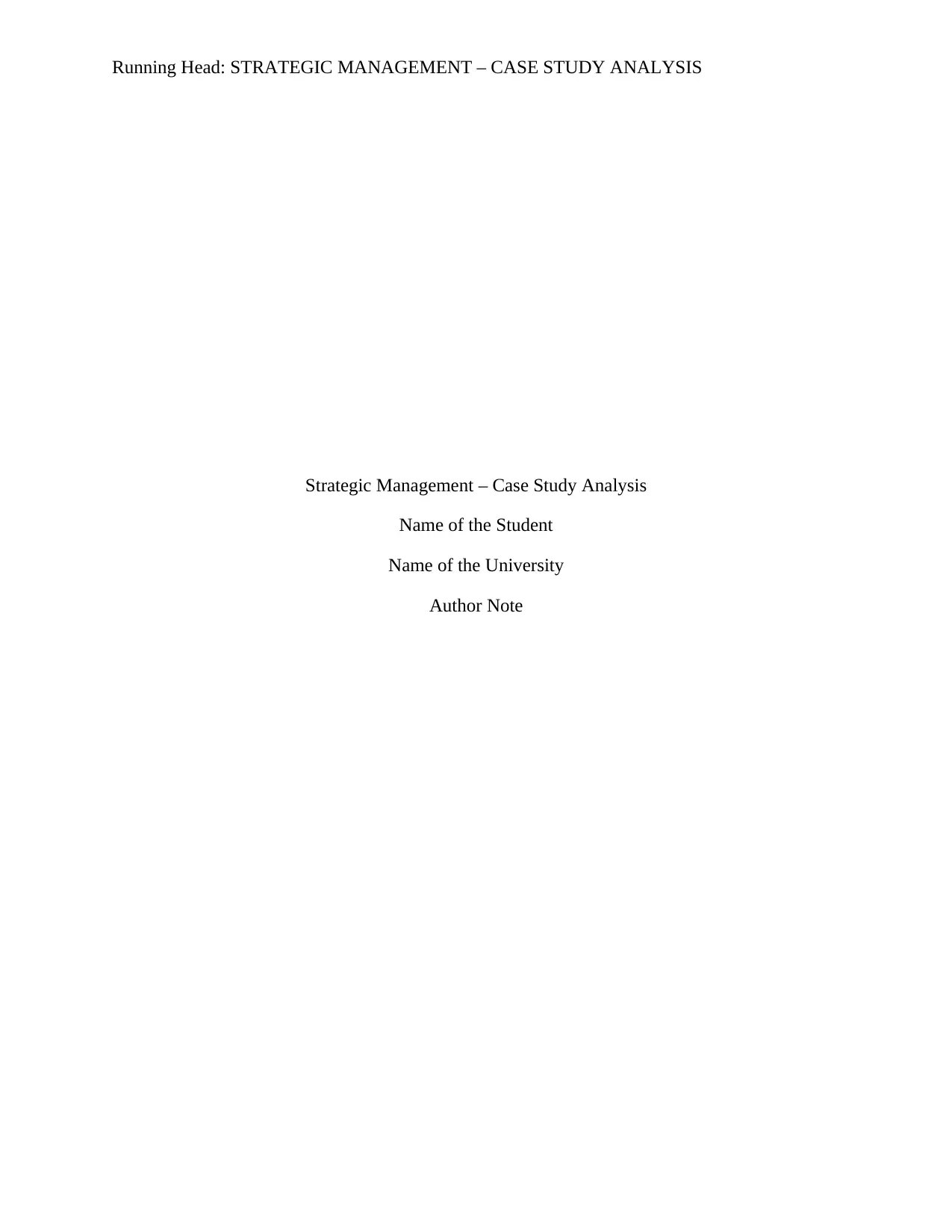
Running Head: STRATEGIC MANAGEMENT – CASE STUDY ANALYSIS
Strategic Management – Case Study Analysis
Name of the Student
Name of the University
Author Note
Strategic Management – Case Study Analysis
Name of the Student
Name of the University
Author Note
Paraphrase This Document
Need a fresh take? Get an instant paraphrase of this document with our AI Paraphraser
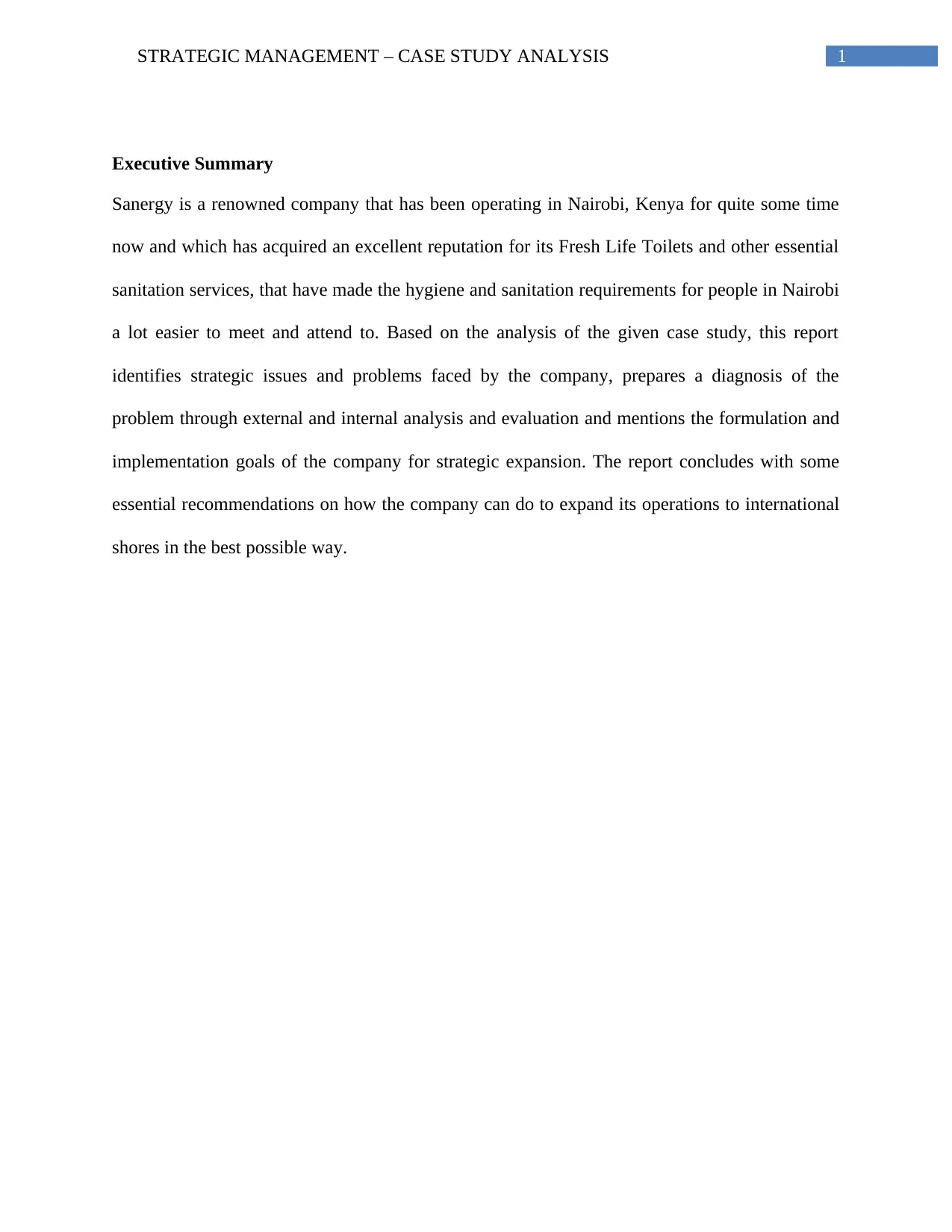
1STRATEGIC MANAGEMENT – CASE STUDY ANALYSIS
Executive Summary
Sanergy is a renowned company that has been operating in Nairobi, Kenya for quite some time
now and which has acquired an excellent reputation for its Fresh Life Toilets and other essential
sanitation services, that have made the hygiene and sanitation requirements for people in Nairobi
a lot easier to meet and attend to. Based on the analysis of the given case study, this report
identifies strategic issues and problems faced by the company, prepares a diagnosis of the
problem through external and internal analysis and evaluation and mentions the formulation and
implementation goals of the company for strategic expansion. The report concludes with some
essential recommendations on how the company can do to expand its operations to international
shores in the best possible way.
Executive Summary
Sanergy is a renowned company that has been operating in Nairobi, Kenya for quite some time
now and which has acquired an excellent reputation for its Fresh Life Toilets and other essential
sanitation services, that have made the hygiene and sanitation requirements for people in Nairobi
a lot easier to meet and attend to. Based on the analysis of the given case study, this report
identifies strategic issues and problems faced by the company, prepares a diagnosis of the
problem through external and internal analysis and evaluation and mentions the formulation and
implementation goals of the company for strategic expansion. The report concludes with some
essential recommendations on how the company can do to expand its operations to international
shores in the best possible way.
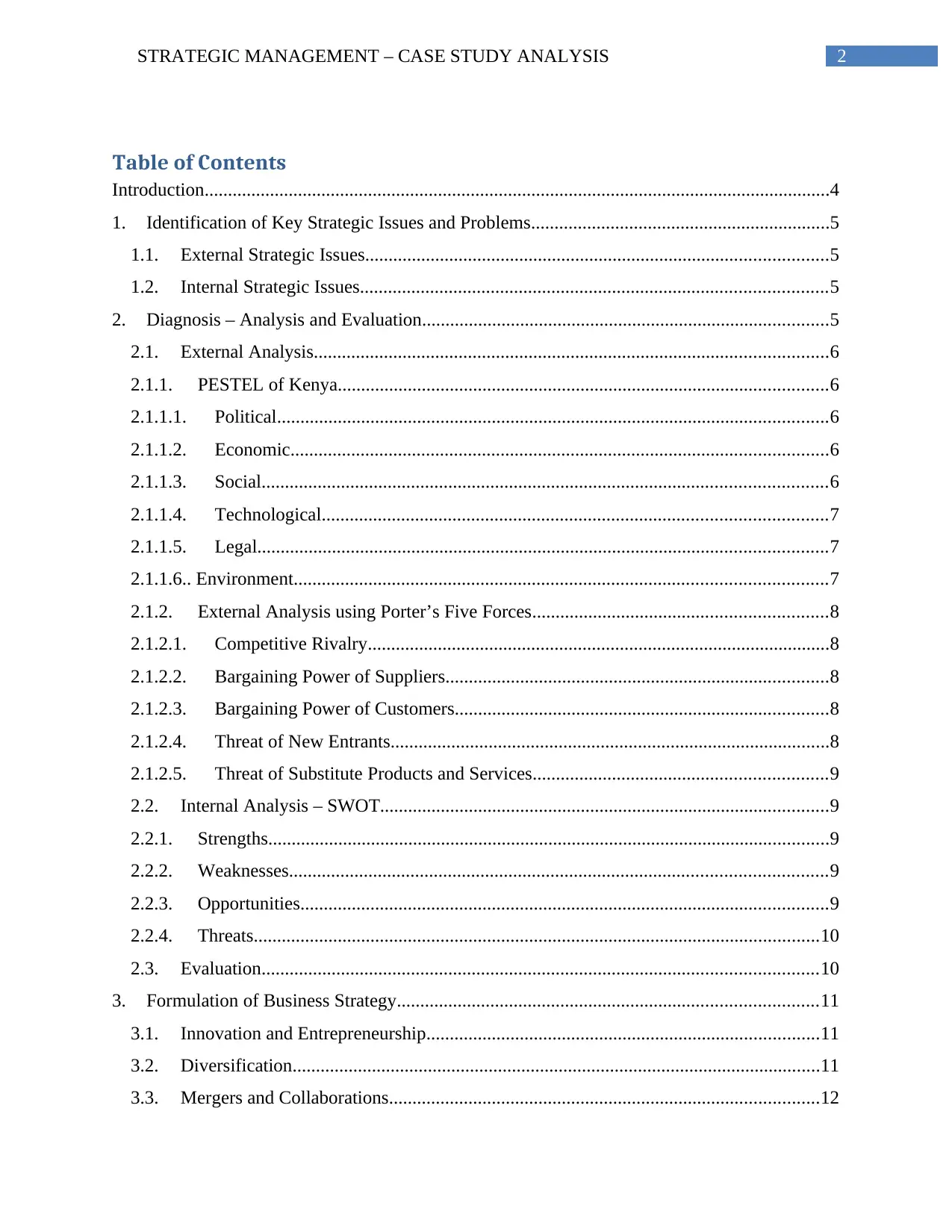
2STRATEGIC MANAGEMENT – CASE STUDY ANALYSIS
Table of Contents
Introduction......................................................................................................................................4
1. Identification of Key Strategic Issues and Problems................................................................5
1.1. External Strategic Issues...................................................................................................5
1.2. Internal Strategic Issues....................................................................................................5
2. Diagnosis – Analysis and Evaluation.......................................................................................5
2.1. External Analysis..............................................................................................................6
2.1.1. PESTEL of Kenya.........................................................................................................6
2.1.1.1. Political......................................................................................................................6
2.1.1.2. Economic...................................................................................................................6
2.1.1.3. Social.........................................................................................................................6
2.1.1.4. Technological............................................................................................................7
2.1.1.5. Legal..........................................................................................................................7
2.1.1.6.. Environment..................................................................................................................7
2.1.2. External Analysis using Porter’s Five Forces...............................................................8
2.1.2.1. Competitive Rivalry...................................................................................................8
2.1.2.2. Bargaining Power of Suppliers..................................................................................8
2.1.2.3. Bargaining Power of Customers................................................................................8
2.1.2.4. Threat of New Entrants..............................................................................................8
2.1.2.5. Threat of Substitute Products and Services...............................................................9
2.2. Internal Analysis – SWOT................................................................................................9
2.2.1. Strengths........................................................................................................................9
2.2.2. Weaknesses...................................................................................................................9
2.2.3. Opportunities.................................................................................................................9
2.2.4. Threats.........................................................................................................................10
2.3. Evaluation.......................................................................................................................10
3. Formulation of Business Strategy..........................................................................................11
3.1. Innovation and Entrepreneurship....................................................................................11
3.2. Diversification.................................................................................................................11
3.3. Mergers and Collaborations............................................................................................12
Table of Contents
Introduction......................................................................................................................................4
1. Identification of Key Strategic Issues and Problems................................................................5
1.1. External Strategic Issues...................................................................................................5
1.2. Internal Strategic Issues....................................................................................................5
2. Diagnosis – Analysis and Evaluation.......................................................................................5
2.1. External Analysis..............................................................................................................6
2.1.1. PESTEL of Kenya.........................................................................................................6
2.1.1.1. Political......................................................................................................................6
2.1.1.2. Economic...................................................................................................................6
2.1.1.3. Social.........................................................................................................................6
2.1.1.4. Technological............................................................................................................7
2.1.1.5. Legal..........................................................................................................................7
2.1.1.6.. Environment..................................................................................................................7
2.1.2. External Analysis using Porter’s Five Forces...............................................................8
2.1.2.1. Competitive Rivalry...................................................................................................8
2.1.2.2. Bargaining Power of Suppliers..................................................................................8
2.1.2.3. Bargaining Power of Customers................................................................................8
2.1.2.4. Threat of New Entrants..............................................................................................8
2.1.2.5. Threat of Substitute Products and Services...............................................................9
2.2. Internal Analysis – SWOT................................................................................................9
2.2.1. Strengths........................................................................................................................9
2.2.2. Weaknesses...................................................................................................................9
2.2.3. Opportunities.................................................................................................................9
2.2.4. Threats.........................................................................................................................10
2.3. Evaluation.......................................................................................................................10
3. Formulation of Business Strategy..........................................................................................11
3.1. Innovation and Entrepreneurship....................................................................................11
3.2. Diversification.................................................................................................................11
3.3. Mergers and Collaborations............................................................................................12
⊘ This is a preview!⊘
Do you want full access?
Subscribe today to unlock all pages.

Trusted by 1+ million students worldwide
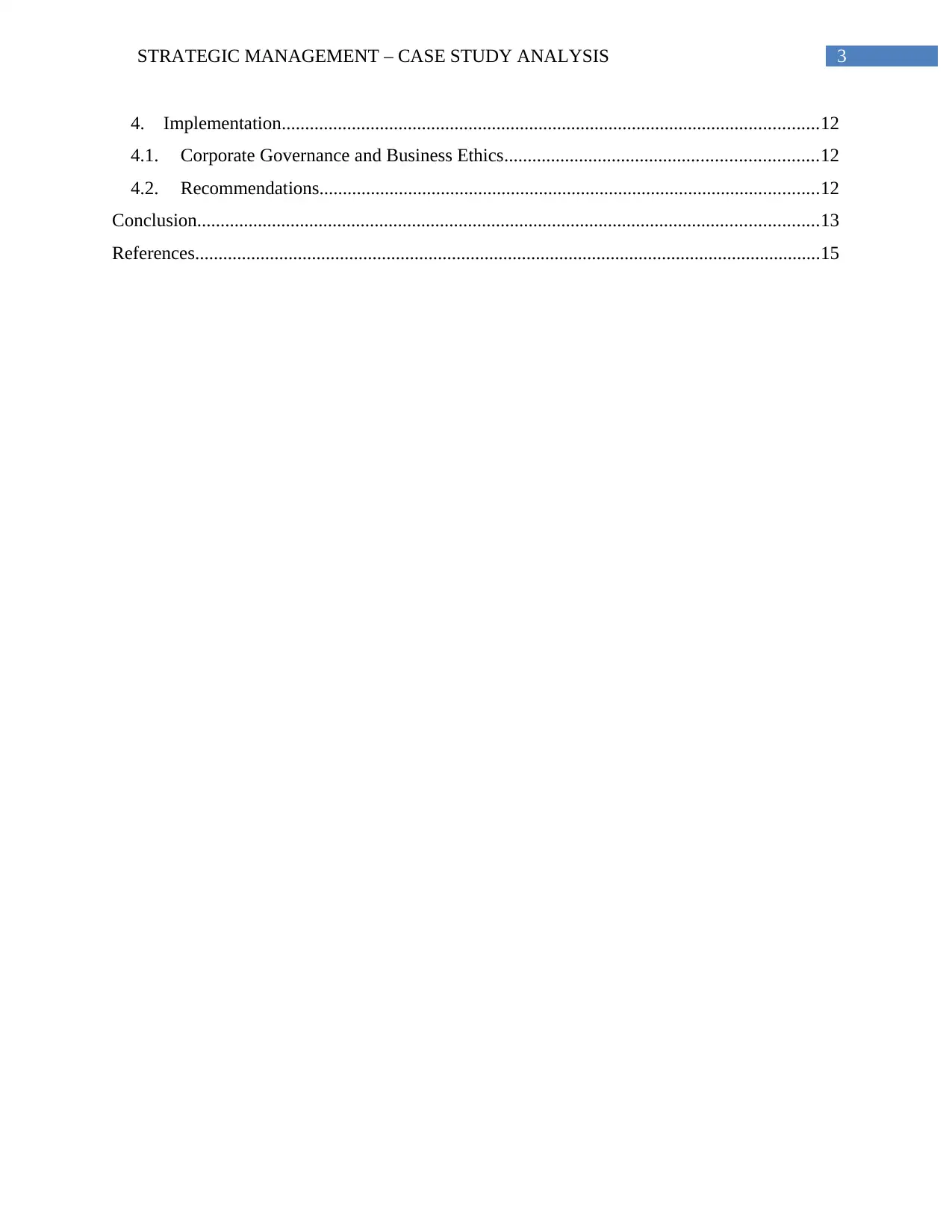
3STRATEGIC MANAGEMENT – CASE STUDY ANALYSIS
4. Implementation...................................................................................................................12
4.1. Corporate Governance and Business Ethics...................................................................12
4.2. Recommendations...........................................................................................................12
Conclusion.....................................................................................................................................13
References......................................................................................................................................15
4. Implementation...................................................................................................................12
4.1. Corporate Governance and Business Ethics...................................................................12
4.2. Recommendations...........................................................................................................12
Conclusion.....................................................................................................................................13
References......................................................................................................................................15
Paraphrase This Document
Need a fresh take? Get an instant paraphrase of this document with our AI Paraphraser
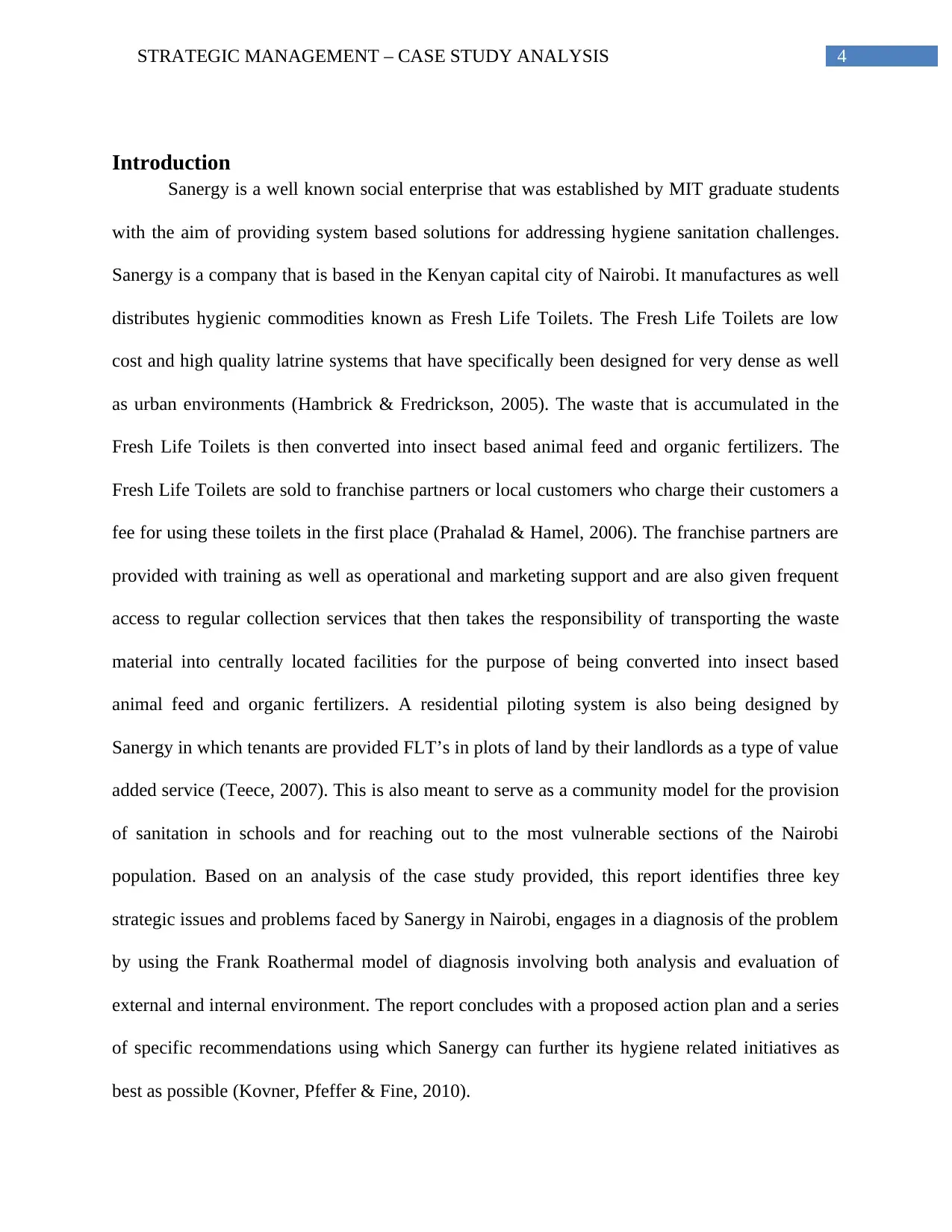
4STRATEGIC MANAGEMENT – CASE STUDY ANALYSIS
Introduction
Sanergy is a well known social enterprise that was established by MIT graduate students
with the aim of providing system based solutions for addressing hygiene sanitation challenges.
Sanergy is a company that is based in the Kenyan capital city of Nairobi. It manufactures as well
distributes hygienic commodities known as Fresh Life Toilets. The Fresh Life Toilets are low
cost and high quality latrine systems that have specifically been designed for very dense as well
as urban environments (Hambrick & Fredrickson, 2005). The waste that is accumulated in the
Fresh Life Toilets is then converted into insect based animal feed and organic fertilizers. The
Fresh Life Toilets are sold to franchise partners or local customers who charge their customers a
fee for using these toilets in the first place (Prahalad & Hamel, 2006). The franchise partners are
provided with training as well as operational and marketing support and are also given frequent
access to regular collection services that then takes the responsibility of transporting the waste
material into centrally located facilities for the purpose of being converted into insect based
animal feed and organic fertilizers. A residential piloting system is also being designed by
Sanergy in which tenants are provided FLT’s in plots of land by their landlords as a type of value
added service (Teece, 2007). This is also meant to serve as a community model for the provision
of sanitation in schools and for reaching out to the most vulnerable sections of the Nairobi
population. Based on an analysis of the case study provided, this report identifies three key
strategic issues and problems faced by Sanergy in Nairobi, engages in a diagnosis of the problem
by using the Frank Roathermal model of diagnosis involving both analysis and evaluation of
external and internal environment. The report concludes with a proposed action plan and a series
of specific recommendations using which Sanergy can further its hygiene related initiatives as
best as possible (Kovner, Pfeffer & Fine, 2010).
Introduction
Sanergy is a well known social enterprise that was established by MIT graduate students
with the aim of providing system based solutions for addressing hygiene sanitation challenges.
Sanergy is a company that is based in the Kenyan capital city of Nairobi. It manufactures as well
distributes hygienic commodities known as Fresh Life Toilets. The Fresh Life Toilets are low
cost and high quality latrine systems that have specifically been designed for very dense as well
as urban environments (Hambrick & Fredrickson, 2005). The waste that is accumulated in the
Fresh Life Toilets is then converted into insect based animal feed and organic fertilizers. The
Fresh Life Toilets are sold to franchise partners or local customers who charge their customers a
fee for using these toilets in the first place (Prahalad & Hamel, 2006). The franchise partners are
provided with training as well as operational and marketing support and are also given frequent
access to regular collection services that then takes the responsibility of transporting the waste
material into centrally located facilities for the purpose of being converted into insect based
animal feed and organic fertilizers. A residential piloting system is also being designed by
Sanergy in which tenants are provided FLT’s in plots of land by their landlords as a type of value
added service (Teece, 2007). This is also meant to serve as a community model for the provision
of sanitation in schools and for reaching out to the most vulnerable sections of the Nairobi
population. Based on an analysis of the case study provided, this report identifies three key
strategic issues and problems faced by Sanergy in Nairobi, engages in a diagnosis of the problem
by using the Frank Roathermal model of diagnosis involving both analysis and evaluation of
external and internal environment. The report concludes with a proposed action plan and a series
of specific recommendations using which Sanergy can further its hygiene related initiatives as
best as possible (Kovner, Pfeffer & Fine, 2010).
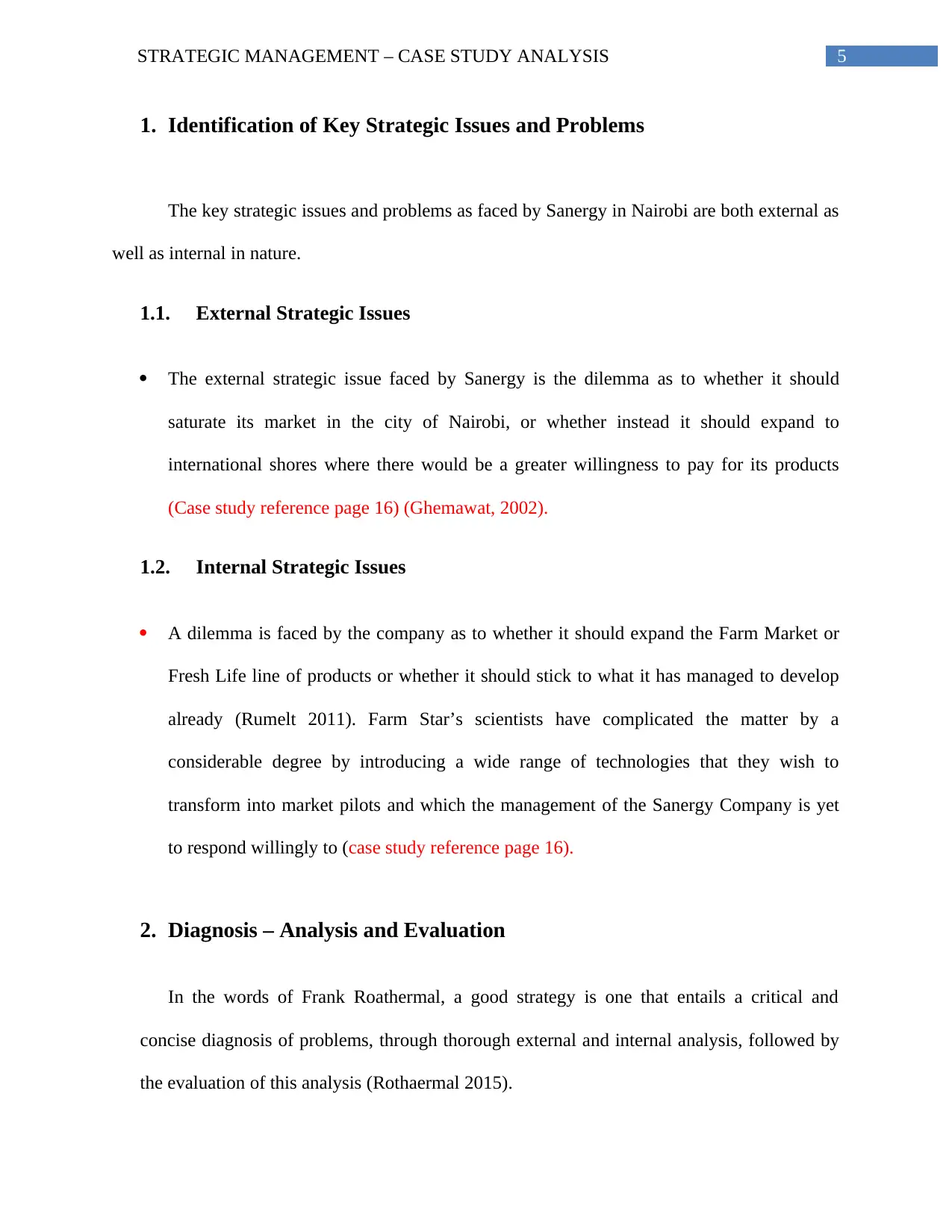
5STRATEGIC MANAGEMENT – CASE STUDY ANALYSIS
1. Identification of Key Strategic Issues and Problems
The key strategic issues and problems as faced by Sanergy in Nairobi are both external as
well as internal in nature.
1.1. External Strategic Issues
The external strategic issue faced by Sanergy is the dilemma as to whether it should
saturate its market in the city of Nairobi, or whether instead it should expand to
international shores where there would be a greater willingness to pay for its products
(Case study reference page 16) (Ghemawat, 2002).
1.2. Internal Strategic Issues
A dilemma is faced by the company as to whether it should expand the Farm Market or
Fresh Life line of products or whether it should stick to what it has managed to develop
already (Rumelt 2011). Farm Star’s scientists have complicated the matter by a
considerable degree by introducing a wide range of technologies that they wish to
transform into market pilots and which the management of the Sanergy Company is yet
to respond willingly to (case study reference page 16).
2. Diagnosis – Analysis and Evaluation
In the words of Frank Roathermal, a good strategy is one that entails a critical and
concise diagnosis of problems, through thorough external and internal analysis, followed by
the evaluation of this analysis (Rothaermal 2015).
1. Identification of Key Strategic Issues and Problems
The key strategic issues and problems as faced by Sanergy in Nairobi are both external as
well as internal in nature.
1.1. External Strategic Issues
The external strategic issue faced by Sanergy is the dilemma as to whether it should
saturate its market in the city of Nairobi, or whether instead it should expand to
international shores where there would be a greater willingness to pay for its products
(Case study reference page 16) (Ghemawat, 2002).
1.2. Internal Strategic Issues
A dilemma is faced by the company as to whether it should expand the Farm Market or
Fresh Life line of products or whether it should stick to what it has managed to develop
already (Rumelt 2011). Farm Star’s scientists have complicated the matter by a
considerable degree by introducing a wide range of technologies that they wish to
transform into market pilots and which the management of the Sanergy Company is yet
to respond willingly to (case study reference page 16).
2. Diagnosis – Analysis and Evaluation
In the words of Frank Roathermal, a good strategy is one that entails a critical and
concise diagnosis of problems, through thorough external and internal analysis, followed by
the evaluation of this analysis (Rothaermal 2015).
⊘ This is a preview!⊘
Do you want full access?
Subscribe today to unlock all pages.

Trusted by 1+ million students worldwide
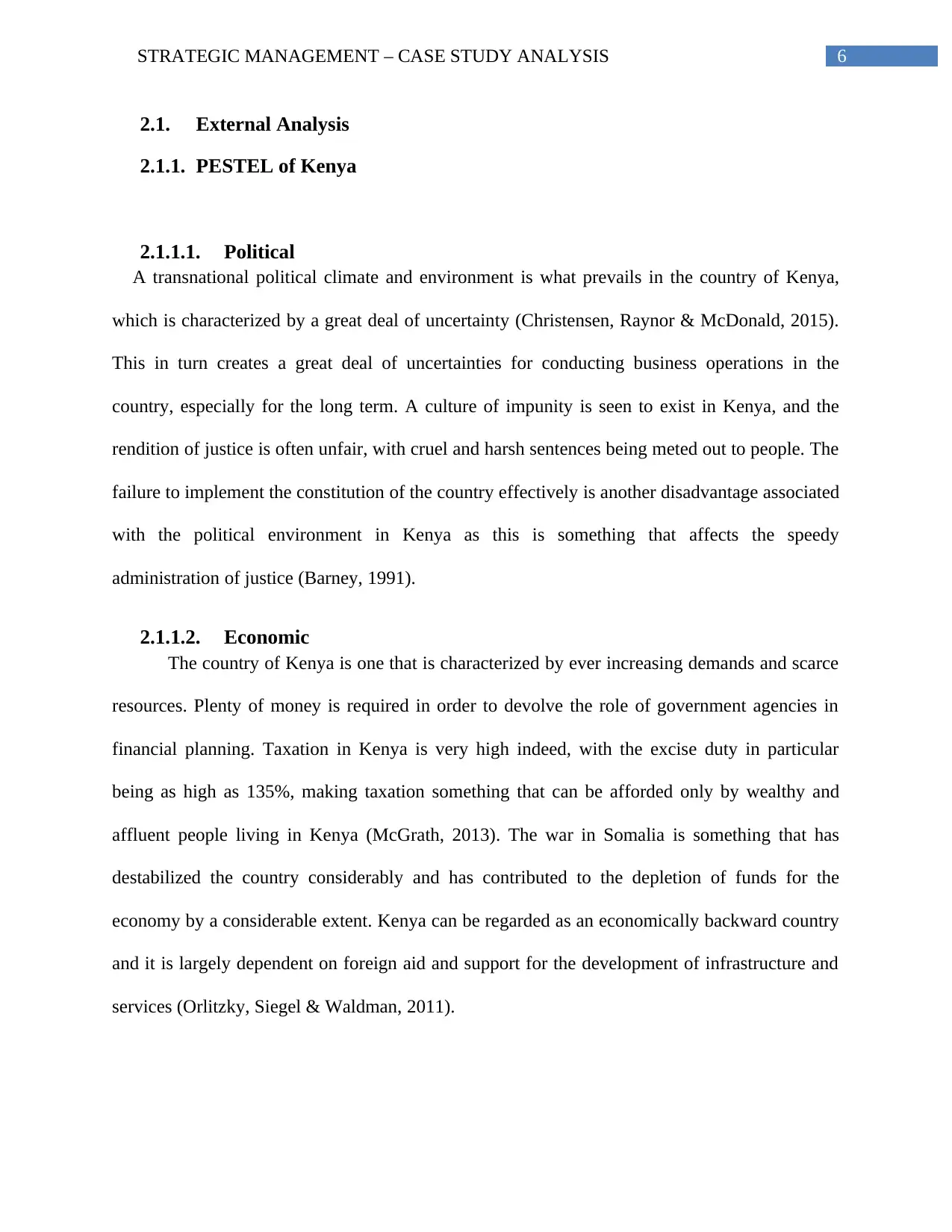
6STRATEGIC MANAGEMENT – CASE STUDY ANALYSIS
2.1. External Analysis
2.1.1. PESTEL of Kenya
2.1.1.1. Political
A transnational political climate and environment is what prevails in the country of Kenya,
which is characterized by a great deal of uncertainty (Christensen, Raynor & McDonald, 2015).
This in turn creates a great deal of uncertainties for conducting business operations in the
country, especially for the long term. A culture of impunity is seen to exist in Kenya, and the
rendition of justice is often unfair, with cruel and harsh sentences being meted out to people. The
failure to implement the constitution of the country effectively is another disadvantage associated
with the political environment in Kenya as this is something that affects the speedy
administration of justice (Barney, 1991).
2.1.1.2. Economic
The country of Kenya is one that is characterized by ever increasing demands and scarce
resources. Plenty of money is required in order to devolve the role of government agencies in
financial planning. Taxation in Kenya is very high indeed, with the excise duty in particular
being as high as 135%, making taxation something that can be afforded only by wealthy and
affluent people living in Kenya (McGrath, 2013). The war in Somalia is something that has
destabilized the country considerably and has contributed to the depletion of funds for the
economy by a considerable extent. Kenya can be regarded as an economically backward country
and it is largely dependent on foreign aid and support for the development of infrastructure and
services (Orlitzky, Siegel & Waldman, 2011).
2.1. External Analysis
2.1.1. PESTEL of Kenya
2.1.1.1. Political
A transnational political climate and environment is what prevails in the country of Kenya,
which is characterized by a great deal of uncertainty (Christensen, Raynor & McDonald, 2015).
This in turn creates a great deal of uncertainties for conducting business operations in the
country, especially for the long term. A culture of impunity is seen to exist in Kenya, and the
rendition of justice is often unfair, with cruel and harsh sentences being meted out to people. The
failure to implement the constitution of the country effectively is another disadvantage associated
with the political environment in Kenya as this is something that affects the speedy
administration of justice (Barney, 1991).
2.1.1.2. Economic
The country of Kenya is one that is characterized by ever increasing demands and scarce
resources. Plenty of money is required in order to devolve the role of government agencies in
financial planning. Taxation in Kenya is very high indeed, with the excise duty in particular
being as high as 135%, making taxation something that can be afforded only by wealthy and
affluent people living in Kenya (McGrath, 2013). The war in Somalia is something that has
destabilized the country considerably and has contributed to the depletion of funds for the
economy by a considerable extent. Kenya can be regarded as an economically backward country
and it is largely dependent on foreign aid and support for the development of infrastructure and
services (Orlitzky, Siegel & Waldman, 2011).
Paraphrase This Document
Need a fresh take? Get an instant paraphrase of this document with our AI Paraphraser
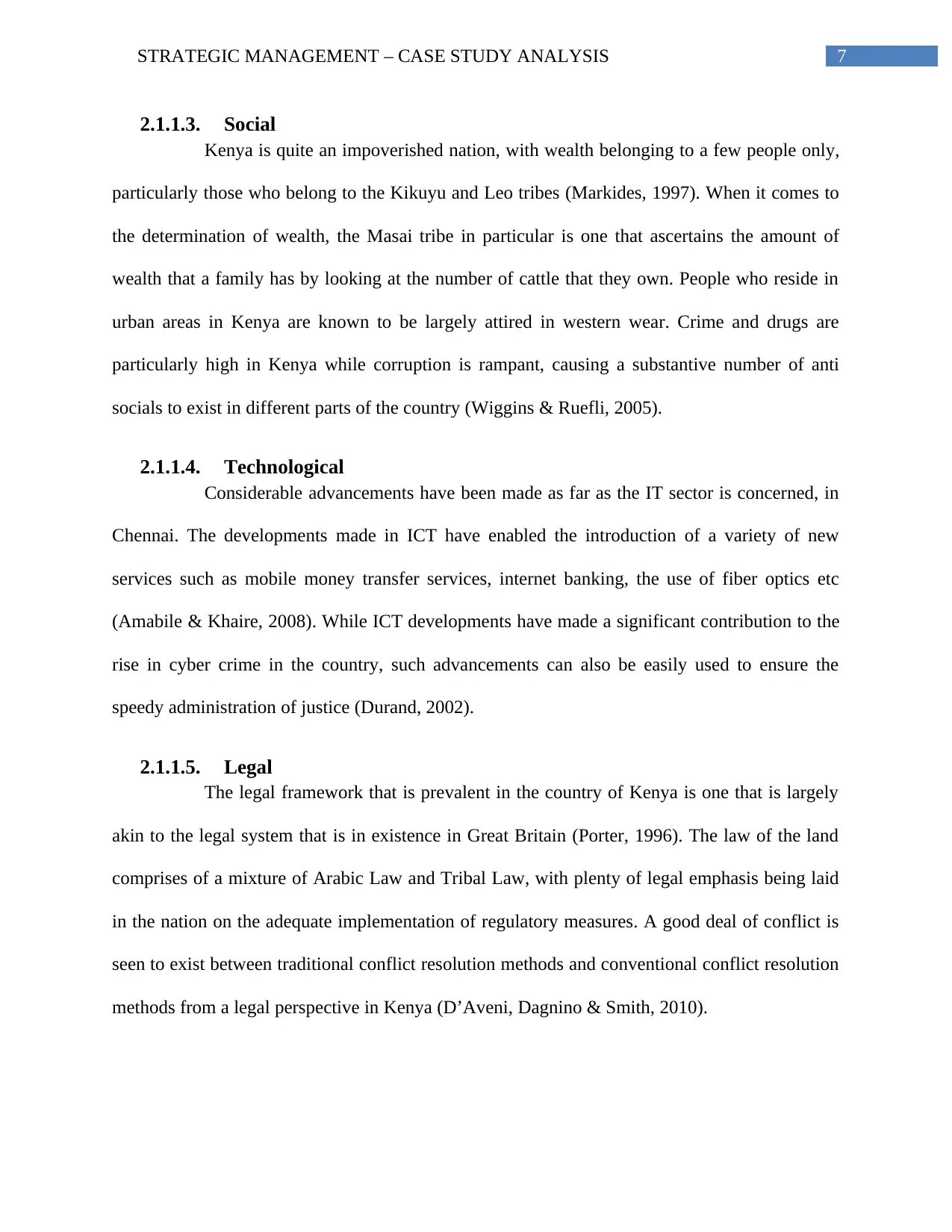
7STRATEGIC MANAGEMENT – CASE STUDY ANALYSIS
2.1.1.3. Social
Kenya is quite an impoverished nation, with wealth belonging to a few people only,
particularly those who belong to the Kikuyu and Leo tribes (Markides, 1997). When it comes to
the determination of wealth, the Masai tribe in particular is one that ascertains the amount of
wealth that a family has by looking at the number of cattle that they own. People who reside in
urban areas in Kenya are known to be largely attired in western wear. Crime and drugs are
particularly high in Kenya while corruption is rampant, causing a substantive number of anti
socials to exist in different parts of the country (Wiggins & Ruefli, 2005).
2.1.1.4. Technological
Considerable advancements have been made as far as the IT sector is concerned, in
Chennai. The developments made in ICT have enabled the introduction of a variety of new
services such as mobile money transfer services, internet banking, the use of fiber optics etc
(Amabile & Khaire, 2008). While ICT developments have made a significant contribution to the
rise in cyber crime in the country, such advancements can also be easily used to ensure the
speedy administration of justice (Durand, 2002).
2.1.1.5. Legal
The legal framework that is prevalent in the country of Kenya is one that is largely
akin to the legal system that is in existence in Great Britain (Porter, 1996). The law of the land
comprises of a mixture of Arabic Law and Tribal Law, with plenty of legal emphasis being laid
in the nation on the adequate implementation of regulatory measures. A good deal of conflict is
seen to exist between traditional conflict resolution methods and conventional conflict resolution
methods from a legal perspective in Kenya (D’Aveni, Dagnino & Smith, 2010).
2.1.1.3. Social
Kenya is quite an impoverished nation, with wealth belonging to a few people only,
particularly those who belong to the Kikuyu and Leo tribes (Markides, 1997). When it comes to
the determination of wealth, the Masai tribe in particular is one that ascertains the amount of
wealth that a family has by looking at the number of cattle that they own. People who reside in
urban areas in Kenya are known to be largely attired in western wear. Crime and drugs are
particularly high in Kenya while corruption is rampant, causing a substantive number of anti
socials to exist in different parts of the country (Wiggins & Ruefli, 2005).
2.1.1.4. Technological
Considerable advancements have been made as far as the IT sector is concerned, in
Chennai. The developments made in ICT have enabled the introduction of a variety of new
services such as mobile money transfer services, internet banking, the use of fiber optics etc
(Amabile & Khaire, 2008). While ICT developments have made a significant contribution to the
rise in cyber crime in the country, such advancements can also be easily used to ensure the
speedy administration of justice (Durand, 2002).
2.1.1.5. Legal
The legal framework that is prevalent in the country of Kenya is one that is largely
akin to the legal system that is in existence in Great Britain (Porter, 1996). The law of the land
comprises of a mixture of Arabic Law and Tribal Law, with plenty of legal emphasis being laid
in the nation on the adequate implementation of regulatory measures. A good deal of conflict is
seen to exist between traditional conflict resolution methods and conventional conflict resolution
methods from a legal perspective in Kenya (D’Aveni, Dagnino & Smith, 2010).
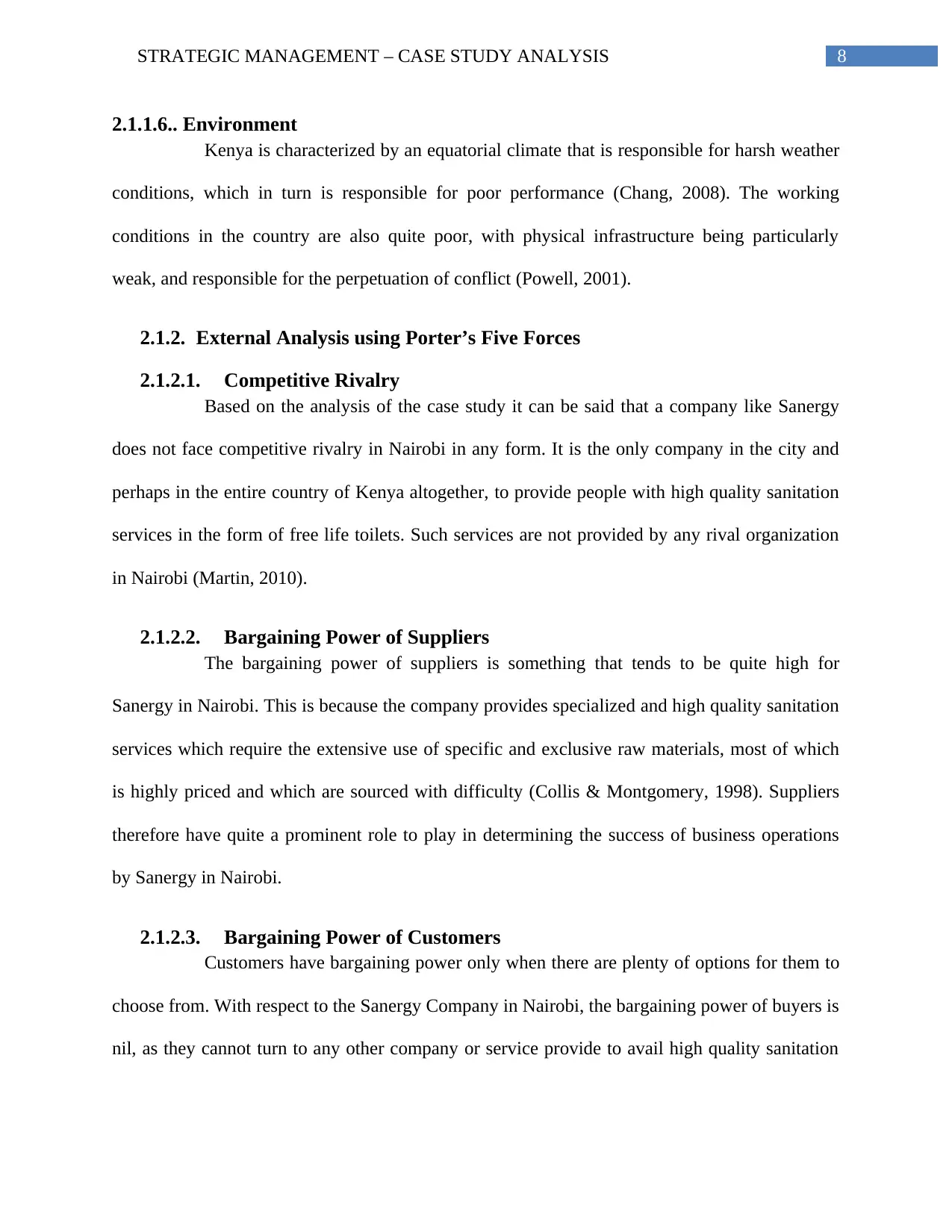
8STRATEGIC MANAGEMENT – CASE STUDY ANALYSIS
2.1.1.6.. Environment
Kenya is characterized by an equatorial climate that is responsible for harsh weather
conditions, which in turn is responsible for poor performance (Chang, 2008). The working
conditions in the country are also quite poor, with physical infrastructure being particularly
weak, and responsible for the perpetuation of conflict (Powell, 2001).
2.1.2. External Analysis using Porter’s Five Forces
2.1.2.1. Competitive Rivalry
Based on the analysis of the case study it can be said that a company like Sanergy
does not face competitive rivalry in Nairobi in any form. It is the only company in the city and
perhaps in the entire country of Kenya altogether, to provide people with high quality sanitation
services in the form of free life toilets. Such services are not provided by any rival organization
in Nairobi (Martin, 2010).
2.1.2.2. Bargaining Power of Suppliers
The bargaining power of suppliers is something that tends to be quite high for
Sanergy in Nairobi. This is because the company provides specialized and high quality sanitation
services which require the extensive use of specific and exclusive raw materials, most of which
is highly priced and which are sourced with difficulty (Collis & Montgomery, 1998). Suppliers
therefore have quite a prominent role to play in determining the success of business operations
by Sanergy in Nairobi.
2.1.2.3. Bargaining Power of Customers
Customers have bargaining power only when there are plenty of options for them to
choose from. With respect to the Sanergy Company in Nairobi, the bargaining power of buyers is
nil, as they cannot turn to any other company or service provide to avail high quality sanitation
2.1.1.6.. Environment
Kenya is characterized by an equatorial climate that is responsible for harsh weather
conditions, which in turn is responsible for poor performance (Chang, 2008). The working
conditions in the country are also quite poor, with physical infrastructure being particularly
weak, and responsible for the perpetuation of conflict (Powell, 2001).
2.1.2. External Analysis using Porter’s Five Forces
2.1.2.1. Competitive Rivalry
Based on the analysis of the case study it can be said that a company like Sanergy
does not face competitive rivalry in Nairobi in any form. It is the only company in the city and
perhaps in the entire country of Kenya altogether, to provide people with high quality sanitation
services in the form of free life toilets. Such services are not provided by any rival organization
in Nairobi (Martin, 2010).
2.1.2.2. Bargaining Power of Suppliers
The bargaining power of suppliers is something that tends to be quite high for
Sanergy in Nairobi. This is because the company provides specialized and high quality sanitation
services which require the extensive use of specific and exclusive raw materials, most of which
is highly priced and which are sourced with difficulty (Collis & Montgomery, 1998). Suppliers
therefore have quite a prominent role to play in determining the success of business operations
by Sanergy in Nairobi.
2.1.2.3. Bargaining Power of Customers
Customers have bargaining power only when there are plenty of options for them to
choose from. With respect to the Sanergy Company in Nairobi, the bargaining power of buyers is
nil, as they cannot turn to any other company or service provide to avail high quality sanitation
⊘ This is a preview!⊘
Do you want full access?
Subscribe today to unlock all pages.

Trusted by 1+ million students worldwide

9STRATEGIC MANAGEMENT – CASE STUDY ANALYSIS
services like Fresh Life Toilets as made available by Sanergy, and that too in large numbers
(Pfeffer & Sutton, 2006).
2.1.2.4. Threat of New Entrants
Sanergy appears to be the only company in Nairobi to provide sophisticated
sanitation facilities in the country. While the threat of new entrants cannot be overlooked
altogether, there are few companies in Nairobi that have the foreign funding source,
infrastructure and man power that is needed to set up a project like Fresh Life Toilets (Porter,
1989).
2.1.2.5. Threat of Substitute Products and Services
It is unlikely that there will be companies that emerge with products and services
that are similar to the Fresh Life Toilets and Farm Market line of products as manufactured by
Sanergy. There is no other company in the city, foreign or otherwise that can engage in the
dedicated provision of high quality and low cost sanitation facilities for customers in the long run
(Porter, 2008).
2.2. Internal Analysis – SWOT
2.2.1. Strengths
The Sanergy Company has plenty of strengths in the form of a skilled
employee base, plenty of manpower and sufficient amounts of foreign funding needed in order to
see its business projects through in Nairobi, and elsewhere if needed. The Bill and Melinda Gates
Foundation has a particularly prominent role to play in financing the business ventures of the
Sanergy Company, and it has many other renowned names on its radar of international financiers
as well.
services like Fresh Life Toilets as made available by Sanergy, and that too in large numbers
(Pfeffer & Sutton, 2006).
2.1.2.4. Threat of New Entrants
Sanergy appears to be the only company in Nairobi to provide sophisticated
sanitation facilities in the country. While the threat of new entrants cannot be overlooked
altogether, there are few companies in Nairobi that have the foreign funding source,
infrastructure and man power that is needed to set up a project like Fresh Life Toilets (Porter,
1989).
2.1.2.5. Threat of Substitute Products and Services
It is unlikely that there will be companies that emerge with products and services
that are similar to the Fresh Life Toilets and Farm Market line of products as manufactured by
Sanergy. There is no other company in the city, foreign or otherwise that can engage in the
dedicated provision of high quality and low cost sanitation facilities for customers in the long run
(Porter, 2008).
2.2. Internal Analysis – SWOT
2.2.1. Strengths
The Sanergy Company has plenty of strengths in the form of a skilled
employee base, plenty of manpower and sufficient amounts of foreign funding needed in order to
see its business projects through in Nairobi, and elsewhere if needed. The Bill and Melinda Gates
Foundation has a particularly prominent role to play in financing the business ventures of the
Sanergy Company, and it has many other renowned names on its radar of international financiers
as well.
Paraphrase This Document
Need a fresh take? Get an instant paraphrase of this document with our AI Paraphraser
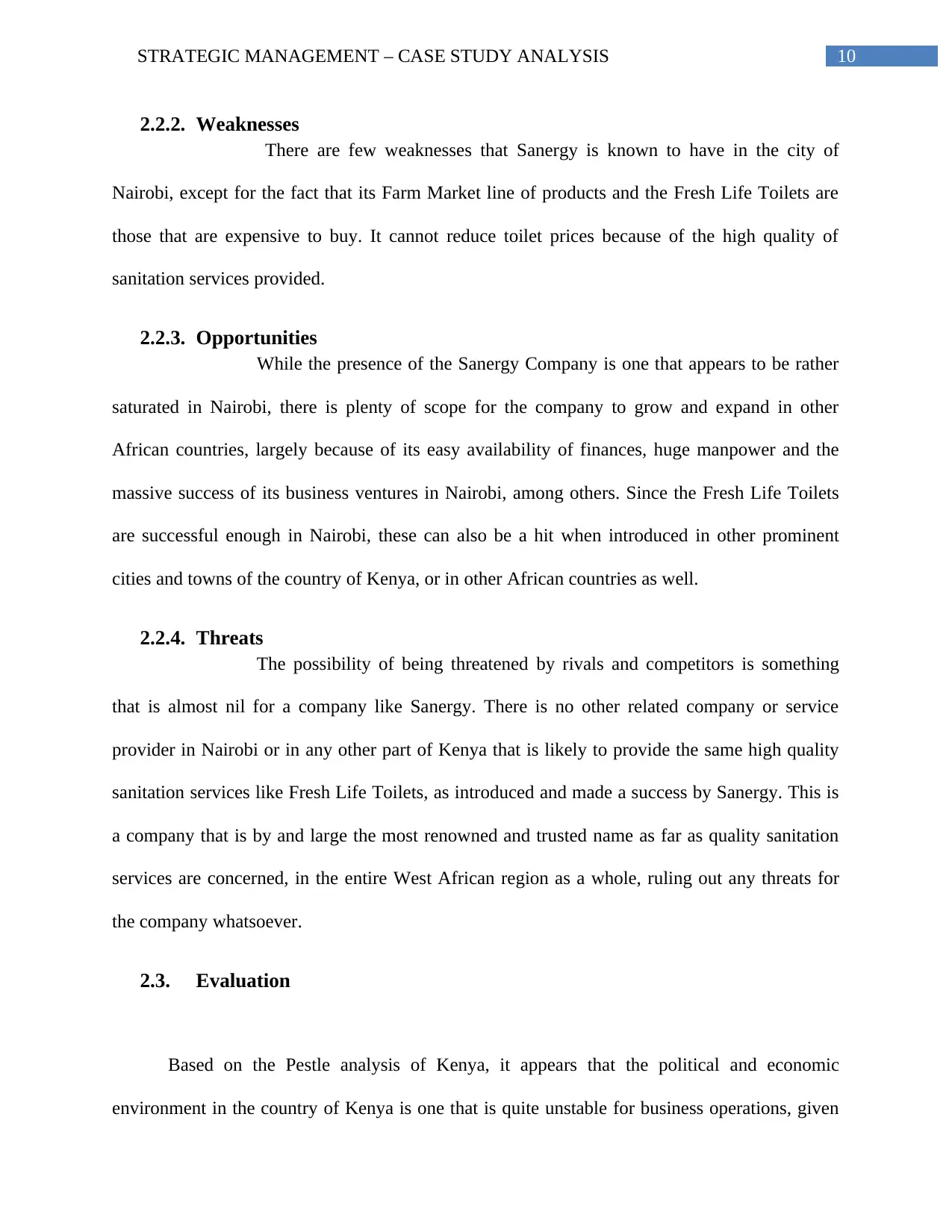
10STRATEGIC MANAGEMENT – CASE STUDY ANALYSIS
2.2.2. Weaknesses
There are few weaknesses that Sanergy is known to have in the city of
Nairobi, except for the fact that its Farm Market line of products and the Fresh Life Toilets are
those that are expensive to buy. It cannot reduce toilet prices because of the high quality of
sanitation services provided.
2.2.3. Opportunities
While the presence of the Sanergy Company is one that appears to be rather
saturated in Nairobi, there is plenty of scope for the company to grow and expand in other
African countries, largely because of its easy availability of finances, huge manpower and the
massive success of its business ventures in Nairobi, among others. Since the Fresh Life Toilets
are successful enough in Nairobi, these can also be a hit when introduced in other prominent
cities and towns of the country of Kenya, or in other African countries as well.
2.2.4. Threats
The possibility of being threatened by rivals and competitors is something
that is almost nil for a company like Sanergy. There is no other related company or service
provider in Nairobi or in any other part of Kenya that is likely to provide the same high quality
sanitation services like Fresh Life Toilets, as introduced and made a success by Sanergy. This is
a company that is by and large the most renowned and trusted name as far as quality sanitation
services are concerned, in the entire West African region as a whole, ruling out any threats for
the company whatsoever.
2.3. Evaluation
Based on the Pestle analysis of Kenya, it appears that the political and economic
environment in the country of Kenya is one that is quite unstable for business operations, given
2.2.2. Weaknesses
There are few weaknesses that Sanergy is known to have in the city of
Nairobi, except for the fact that its Farm Market line of products and the Fresh Life Toilets are
those that are expensive to buy. It cannot reduce toilet prices because of the high quality of
sanitation services provided.
2.2.3. Opportunities
While the presence of the Sanergy Company is one that appears to be rather
saturated in Nairobi, there is plenty of scope for the company to grow and expand in other
African countries, largely because of its easy availability of finances, huge manpower and the
massive success of its business ventures in Nairobi, among others. Since the Fresh Life Toilets
are successful enough in Nairobi, these can also be a hit when introduced in other prominent
cities and towns of the country of Kenya, or in other African countries as well.
2.2.4. Threats
The possibility of being threatened by rivals and competitors is something
that is almost nil for a company like Sanergy. There is no other related company or service
provider in Nairobi or in any other part of Kenya that is likely to provide the same high quality
sanitation services like Fresh Life Toilets, as introduced and made a success by Sanergy. This is
a company that is by and large the most renowned and trusted name as far as quality sanitation
services are concerned, in the entire West African region as a whole, ruling out any threats for
the company whatsoever.
2.3. Evaluation
Based on the Pestle analysis of Kenya, it appears that the political and economic
environment in the country of Kenya is one that is quite unstable for business operations, given
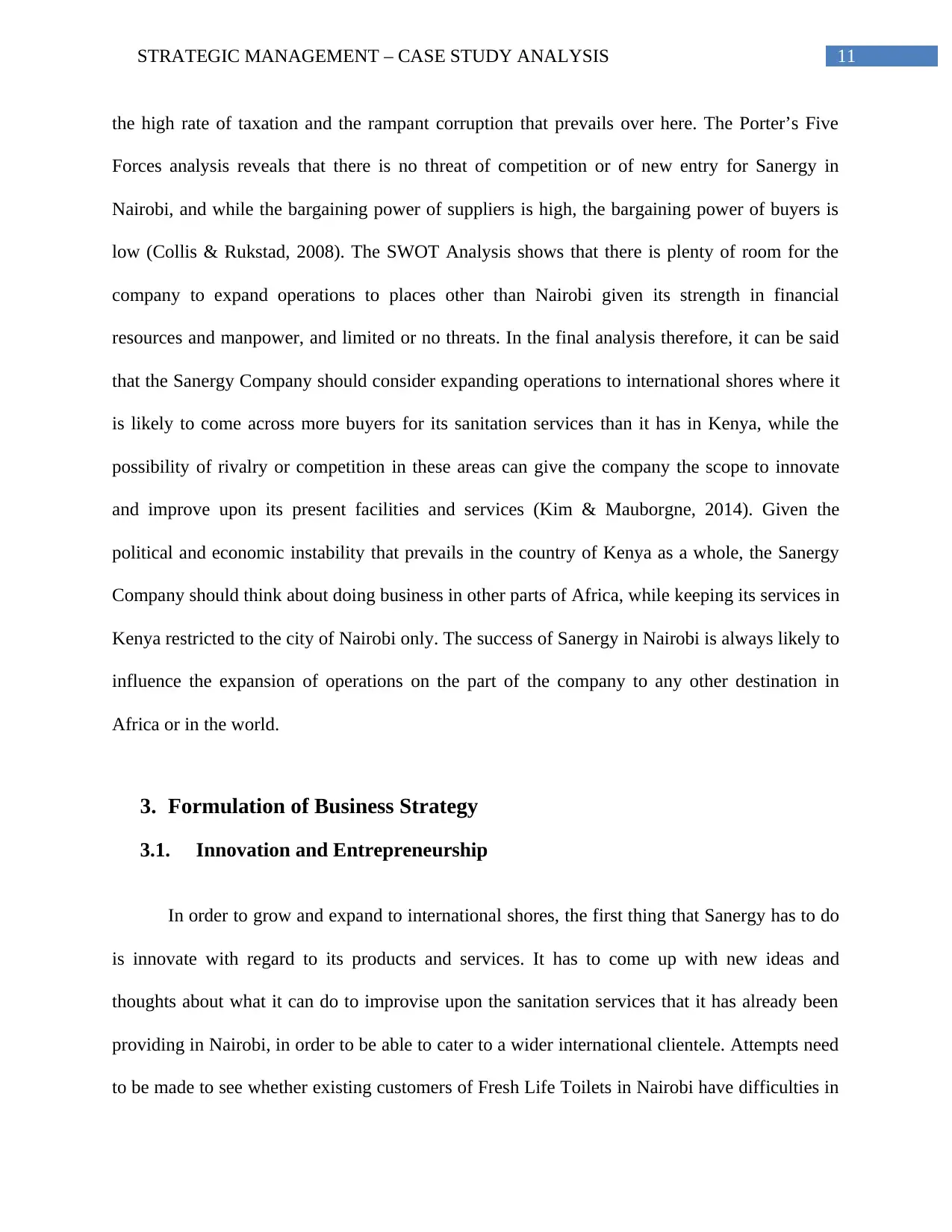
11STRATEGIC MANAGEMENT – CASE STUDY ANALYSIS
the high rate of taxation and the rampant corruption that prevails over here. The Porter’s Five
Forces analysis reveals that there is no threat of competition or of new entry for Sanergy in
Nairobi, and while the bargaining power of suppliers is high, the bargaining power of buyers is
low (Collis & Rukstad, 2008). The SWOT Analysis shows that there is plenty of room for the
company to expand operations to places other than Nairobi given its strength in financial
resources and manpower, and limited or no threats. In the final analysis therefore, it can be said
that the Sanergy Company should consider expanding operations to international shores where it
is likely to come across more buyers for its sanitation services than it has in Kenya, while the
possibility of rivalry or competition in these areas can give the company the scope to innovate
and improve upon its present facilities and services (Kim & Mauborgne, 2014). Given the
political and economic instability that prevails in the country of Kenya as a whole, the Sanergy
Company should think about doing business in other parts of Africa, while keeping its services in
Kenya restricted to the city of Nairobi only. The success of Sanergy in Nairobi is always likely to
influence the expansion of operations on the part of the company to any other destination in
Africa or in the world.
3. Formulation of Business Strategy
3.1. Innovation and Entrepreneurship
In order to grow and expand to international shores, the first thing that Sanergy has to do
is innovate with regard to its products and services. It has to come up with new ideas and
thoughts about what it can do to improvise upon the sanitation services that it has already been
providing in Nairobi, in order to be able to cater to a wider international clientele. Attempts need
to be made to see whether existing customers of Fresh Life Toilets in Nairobi have difficulties in
the high rate of taxation and the rampant corruption that prevails over here. The Porter’s Five
Forces analysis reveals that there is no threat of competition or of new entry for Sanergy in
Nairobi, and while the bargaining power of suppliers is high, the bargaining power of buyers is
low (Collis & Rukstad, 2008). The SWOT Analysis shows that there is plenty of room for the
company to expand operations to places other than Nairobi given its strength in financial
resources and manpower, and limited or no threats. In the final analysis therefore, it can be said
that the Sanergy Company should consider expanding operations to international shores where it
is likely to come across more buyers for its sanitation services than it has in Kenya, while the
possibility of rivalry or competition in these areas can give the company the scope to innovate
and improve upon its present facilities and services (Kim & Mauborgne, 2014). Given the
political and economic instability that prevails in the country of Kenya as a whole, the Sanergy
Company should think about doing business in other parts of Africa, while keeping its services in
Kenya restricted to the city of Nairobi only. The success of Sanergy in Nairobi is always likely to
influence the expansion of operations on the part of the company to any other destination in
Africa or in the world.
3. Formulation of Business Strategy
3.1. Innovation and Entrepreneurship
In order to grow and expand to international shores, the first thing that Sanergy has to do
is innovate with regard to its products and services. It has to come up with new ideas and
thoughts about what it can do to improvise upon the sanitation services that it has already been
providing in Nairobi, in order to be able to cater to a wider international clientele. Attempts need
to be made to see whether existing customers of Fresh Life Toilets in Nairobi have difficulties in
⊘ This is a preview!⊘
Do you want full access?
Subscribe today to unlock all pages.

Trusted by 1+ million students worldwide
1 out of 18
Related Documents
Your All-in-One AI-Powered Toolkit for Academic Success.
+13062052269
info@desklib.com
Available 24*7 on WhatsApp / Email
![[object Object]](/_next/static/media/star-bottom.7253800d.svg)
Unlock your academic potential
Copyright © 2020–2025 A2Z Services. All Rights Reserved. Developed and managed by ZUCOL.




